Easy Homemade Gluten Free Bread Recipe
This post may contain affiliate links. As an Amazon Associate, I earn from qualifying purchases. Please read my disclosure.This homemade, healthy gluten-free bread recipe is super easy to make, and has a soft chewy texture! It’s easy to slice and works well for sandwiches, toast, and any of your other favorite bread-based meals. Includes instructions for making gluten free bread in the oven, and how to make gluten free bread in a bread machine as well! This is such a simple bread recipe, anyone can make it!
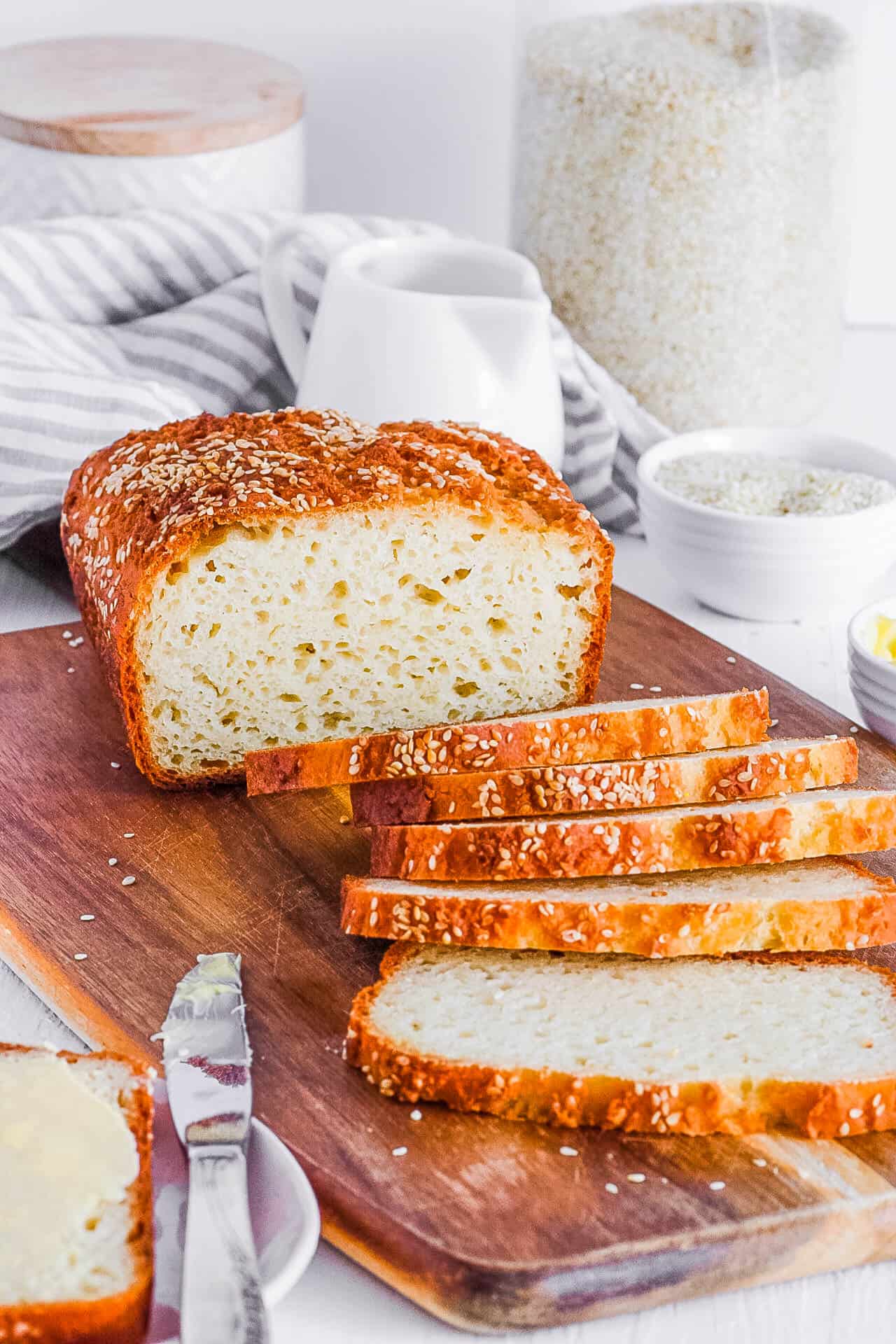
This easy gluten free bread recipe is so soft, fluffy, and super versatile too!
You can use it for sandwiches (like my favorite Panera Mediterranean veggie sandwich copycat recipe or a classic banana peanut butter sandwich), grilled cheese, as a base for these breakfast toast ideas, bread pudding, for regular healthy french toast or a crock pot french toast casserole, making croutons – pretty much everything!
This is the healthiest gluten free bread recipe that tastes just like regular bread!
I don’t love most store-bought gluten-free bread, because it has a ton of additives and more processed starches to make up for the fact that it can’t use wheat flour or any other gluten containing grains ingredients (rye, barley, etc). The result might be gluten-free, but you’re also eating bread that’s higher in refined carbs and sugar, and low in fiber, protein, and other critical nutrients.
While there are some good gluten free bread brands out there (see the FAQs below for which ones I recommend), they can be hard to find and are also pretty expensive compared to regular bread!
That is why I am SUPER excited about this whole grain gluten-free bread recipe with yeast, which not only tastes great but is also really great for you!
Whether you have celiac disease, a diagnosed gluten allergy / sensitivity, are following a gluten free diet, or just want to try a different homemade healthy bread, this bakery style recipe is for you!
👩🏽🍳 Why This Recipe Works
- Made with whole grains
- Simple to customize (dairy free, with a vegan option)
- High in fiber
- Super healthy
- Low sugar gf bread
- Soft and tender crumb
- Amazing recipe for bread lovers!
- Great for kids and families
- Easy to make in the bread machine or the oven
- Best gluten-free bread recipe that actually tastes good!
Latest Recipe Video!
🥘 Ingredients
This low calorie gluten free bread recipe can be made with simple ingredients found in your pantry or at your local grocery store!
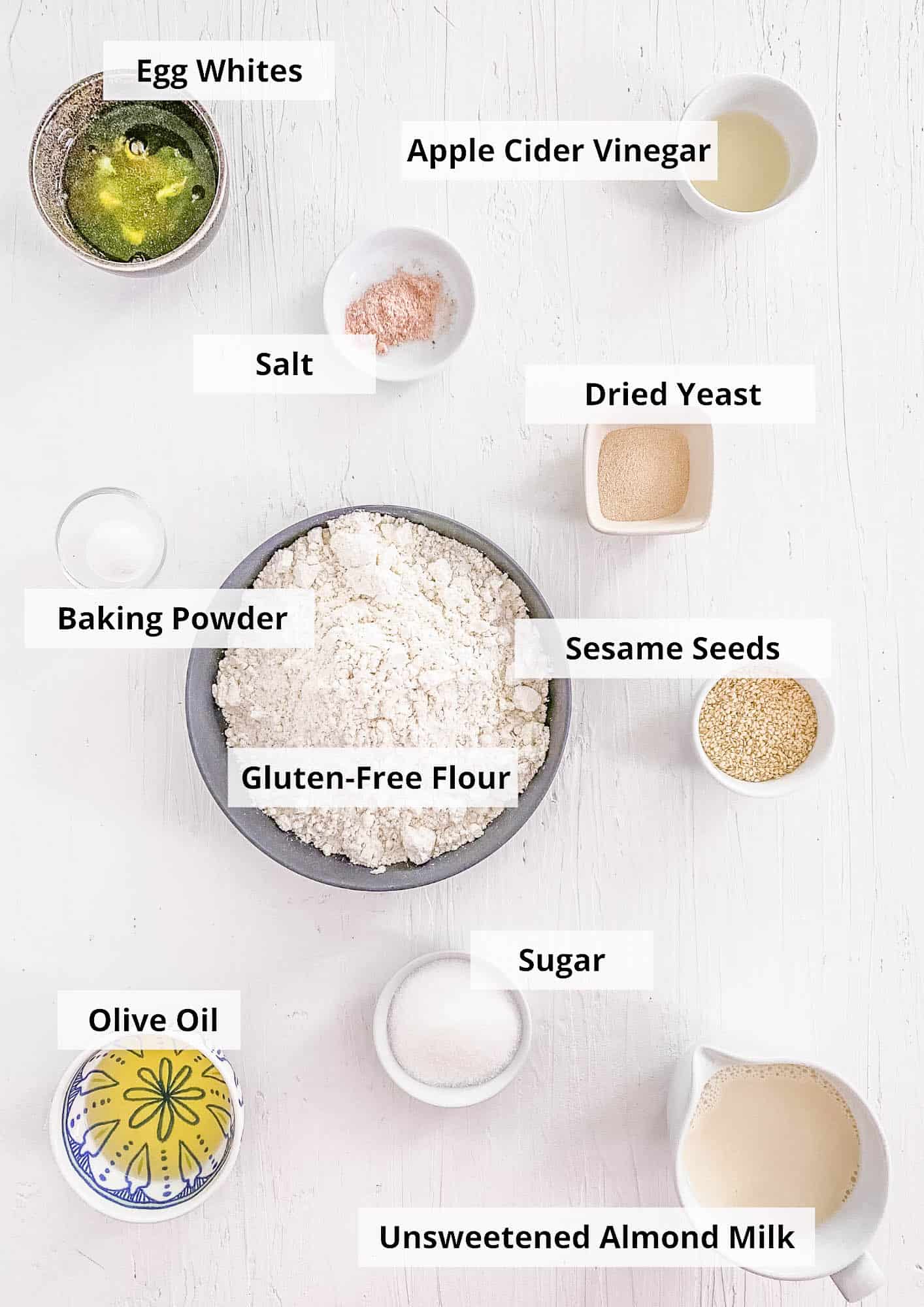
- Gluten Free Flour: Make sure to find one with xanthan gum added. Typically gluten free flour blends will be a mixture of brown rice flour, potato flour, tapioca starch (or potato starch), maybe a few other gf flours and xanthan gum.
- Dried Yeast, Apple Cider Vinegar, And Baking Powder: All of these three ingredients are leavening agents, which means they are key to helping this healthy gluten free bread rise!
- Cane Sugar, Warm Almond Milk, And Salt: To activate the yeast and add flavor. Unsweetened almond milk instead of regular milk also keeps this recipe dairy-free. While I haven’t tested other plant based milks, I do think that any low fat non dairy milk should work, just make sure it’s unsweetened.
- Egg Whites and Olive Oil: Acts as a binder for this gluten free bread recipe! To make this gluten free bread vegan and dairy free, you could try replacing the egg whites with aquafaba (which you can find more details on in this guide to vegan egg substitutes). You would use 2 tablespoons of aquafaba to replace one egg white. This recipe calls for 3 egg whites, so you’d need 6 tablespoons of aquafaba as a replacement.
- Sesame Seeds for topping (a little bit goes a long way!) or you can also use sunflower seeds, pumpkin seeds, or a mix of chopped nuts and seeds! Topping your wheat free bread with seeds is optional although they do add a delicious flavor.
🔪 Instructions
Even if you’re not an experienced baker, you can still make this healthy gluten free sandwich bread recipe! Here’s how to make gluten free bread in the oven (and see below for bread machine instructions).
Proof The Yeast: In a small bowl mix together the yeast, sugar and warm milk. Stir, cover and set aside in a dry, warm place (typically room temperature) to proof for about 10 minutes.
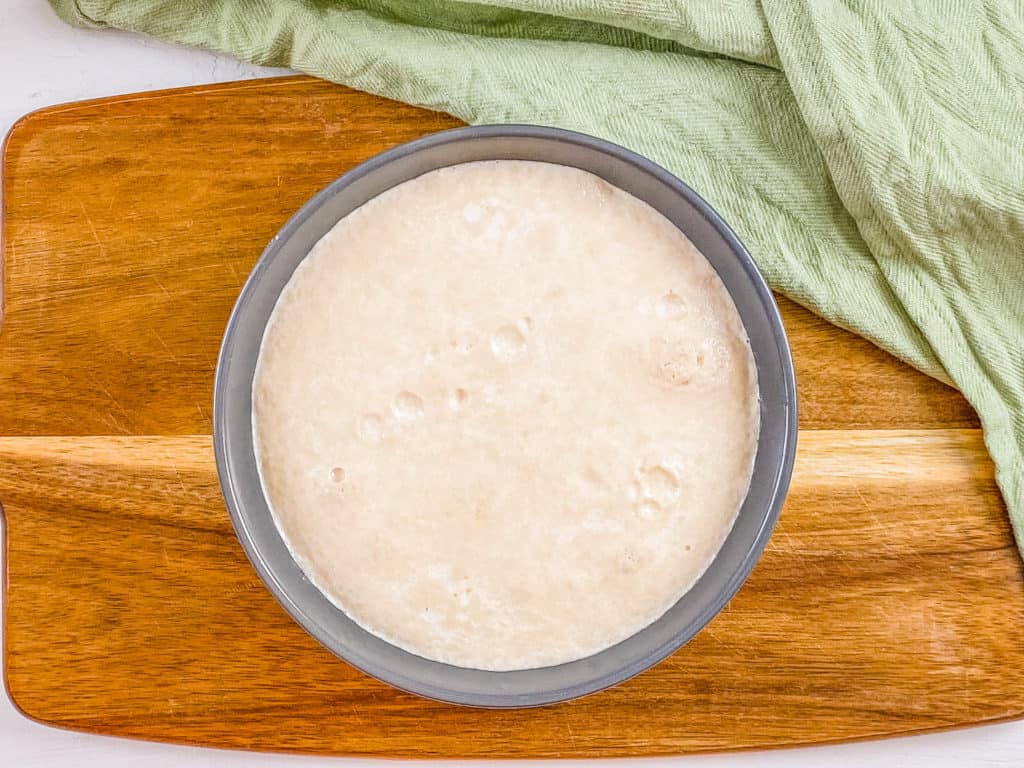
Combine Dry Ingredients: Whisk together the flour, baking powder and salt in the large bowl of a stand mixer.
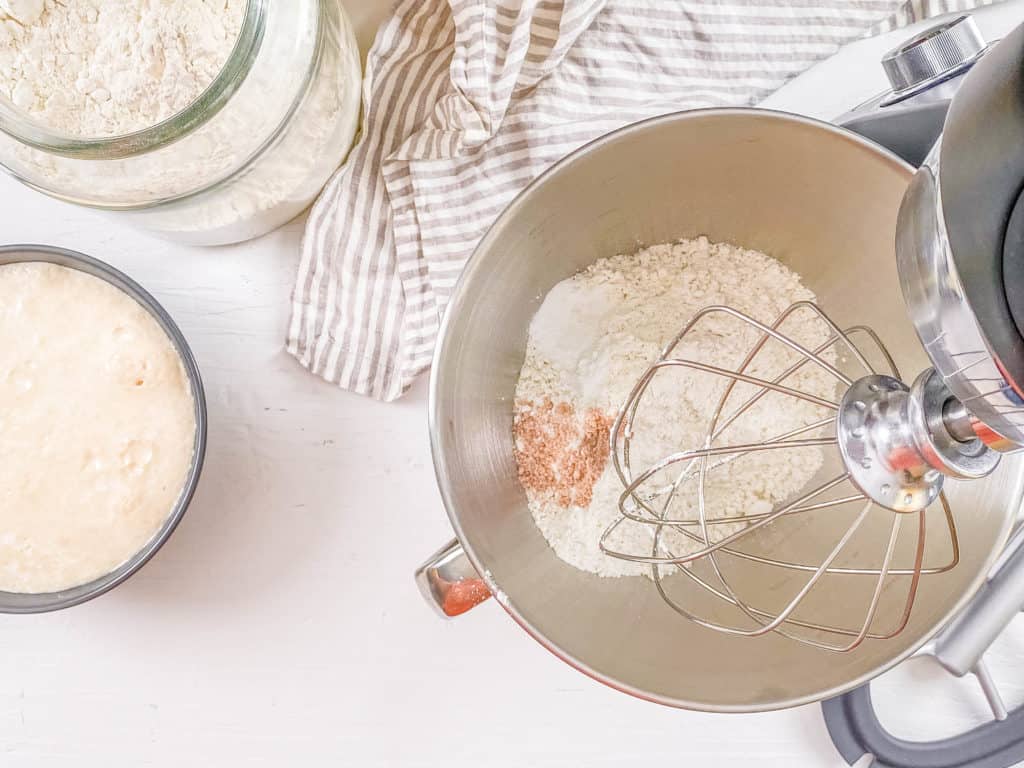
Mix Wet Ingredients: When the yeast starts to bubble add it, along with the apple cider vinegar, oil and egg whites to the flour mixture.
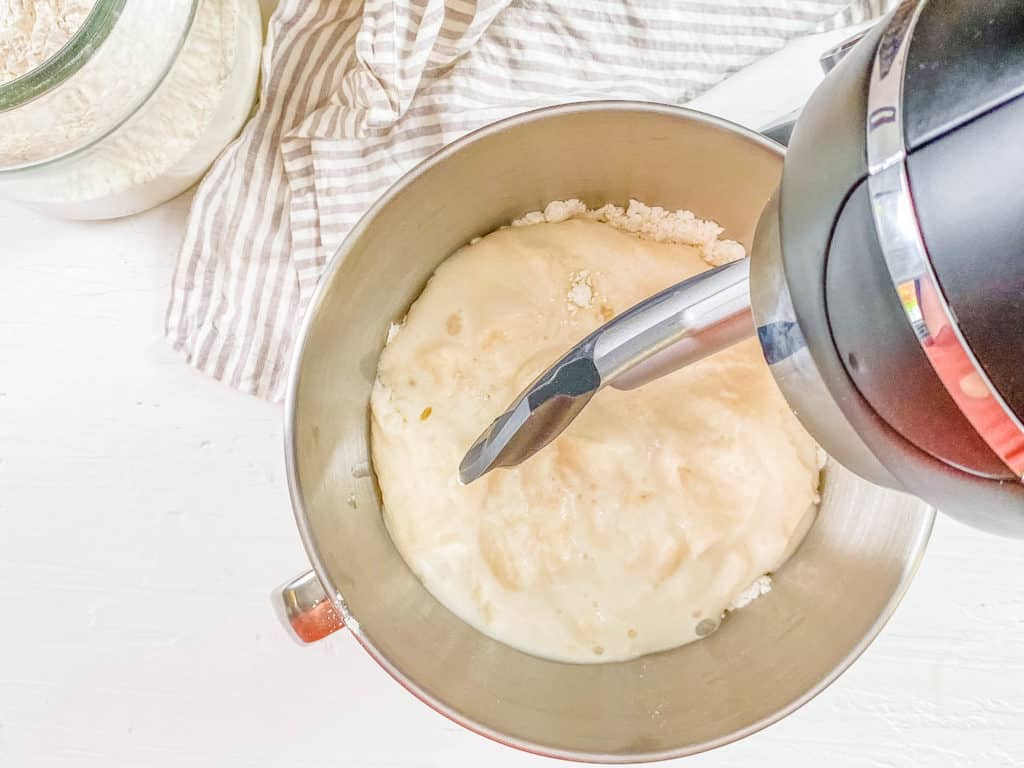
Mix Dough: Use the paddle attachment (not a dough hook) and beat the batter for 30 seconds until combined. Scrape down the edges and continue to beat for a further 3 minutes on a medium speed.
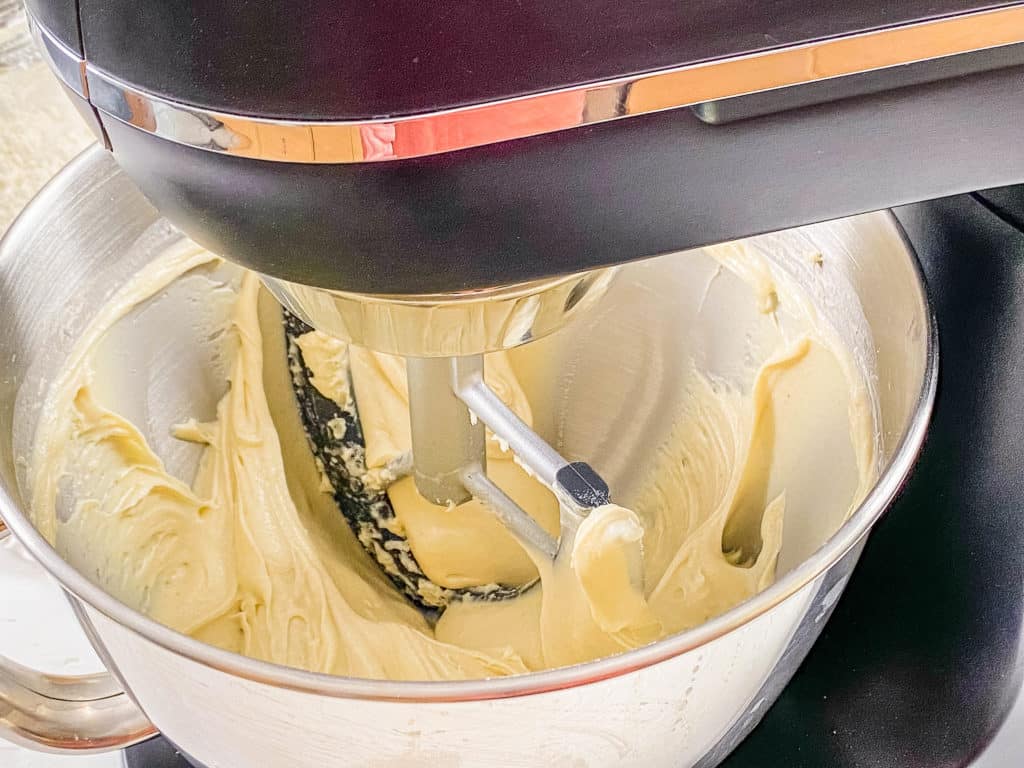
Add Gluten-Free Bread Dough To Bread Pan: Line a 13 x 5 inch bread tin with baking paper, lightly spray it with oil and fill the tin with batter. Smooth off the top with a rubber spatula.
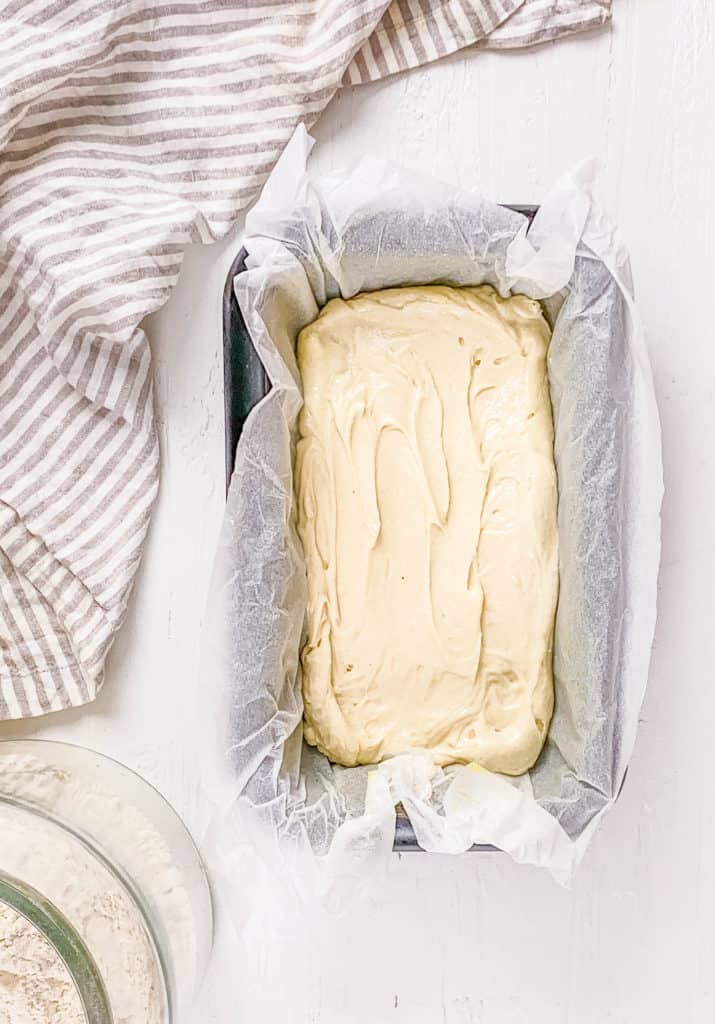
Allow Dough To Rise: Sprinkle with sesame seeds if using, loosely cover with plastic wrap and a tea towel and place in a warm spot to allow the dough to rise for 1 hour. When you have about 15 minutes left for your dough to finish rising, preheat the oven to 350 degrees F / 180 C.
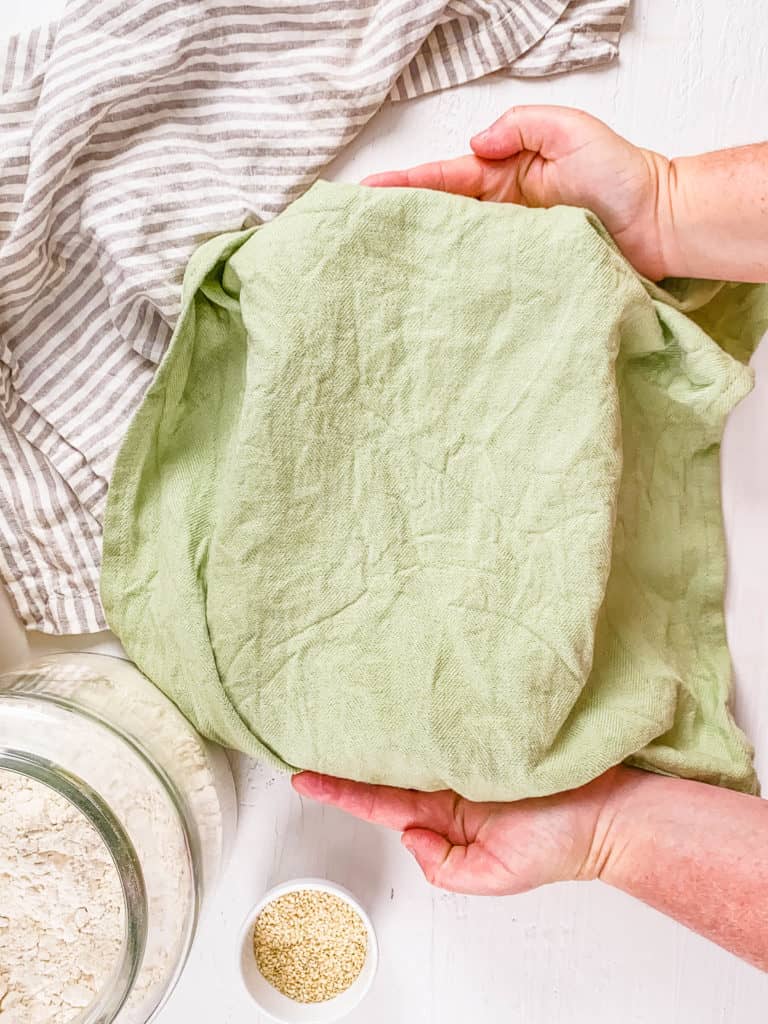
Bake: Remove the plastic wrap and place the bread loaf pan in the oven. Cook for 60 – 65 minutes, cover with foil midway through to stop it from burning.
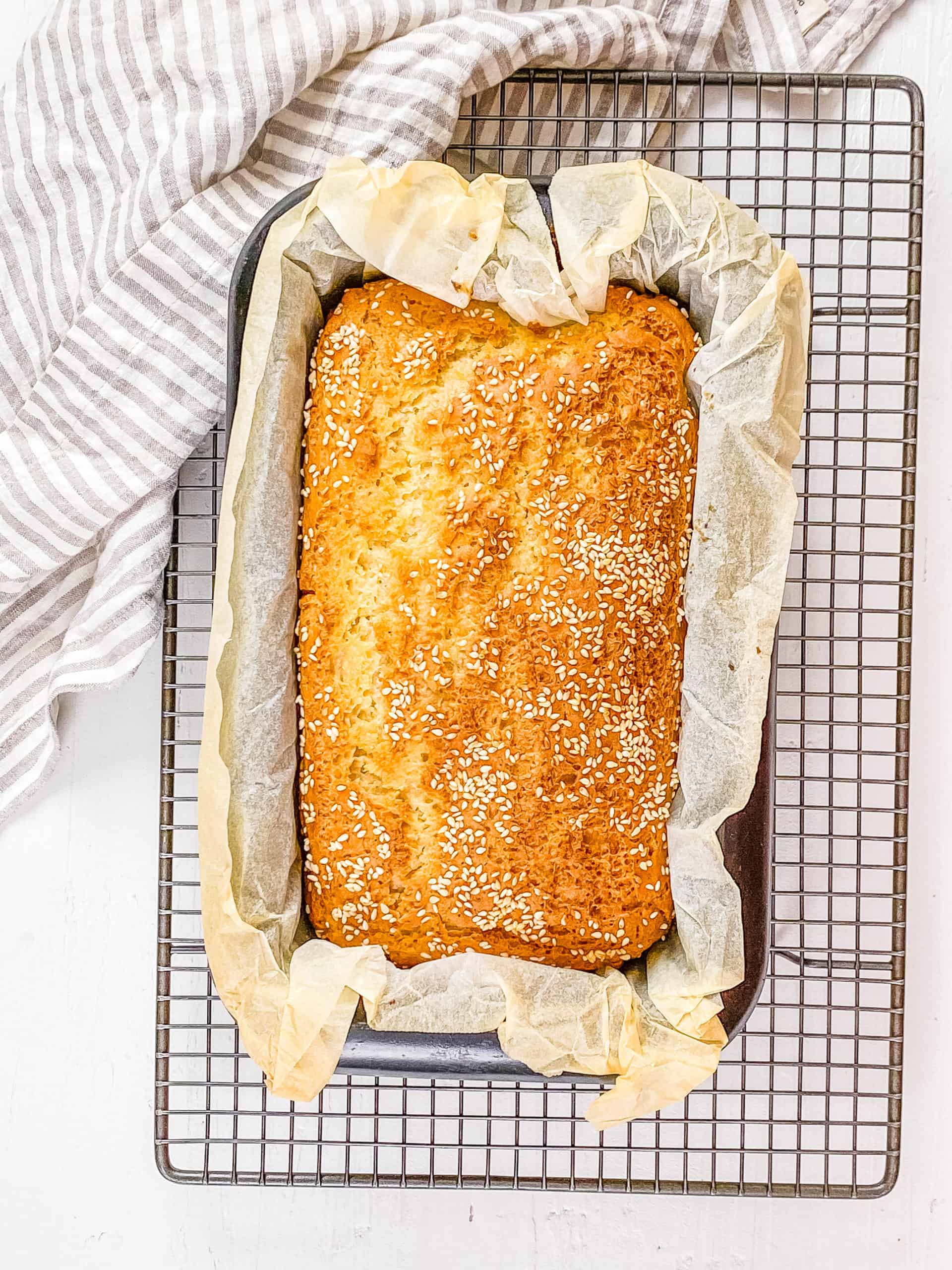
Cool On A Wire Rack: When cooked through, remove from the oven, cool in the bread pan for 5 minutes then allow to cool completely on a cooling rack.
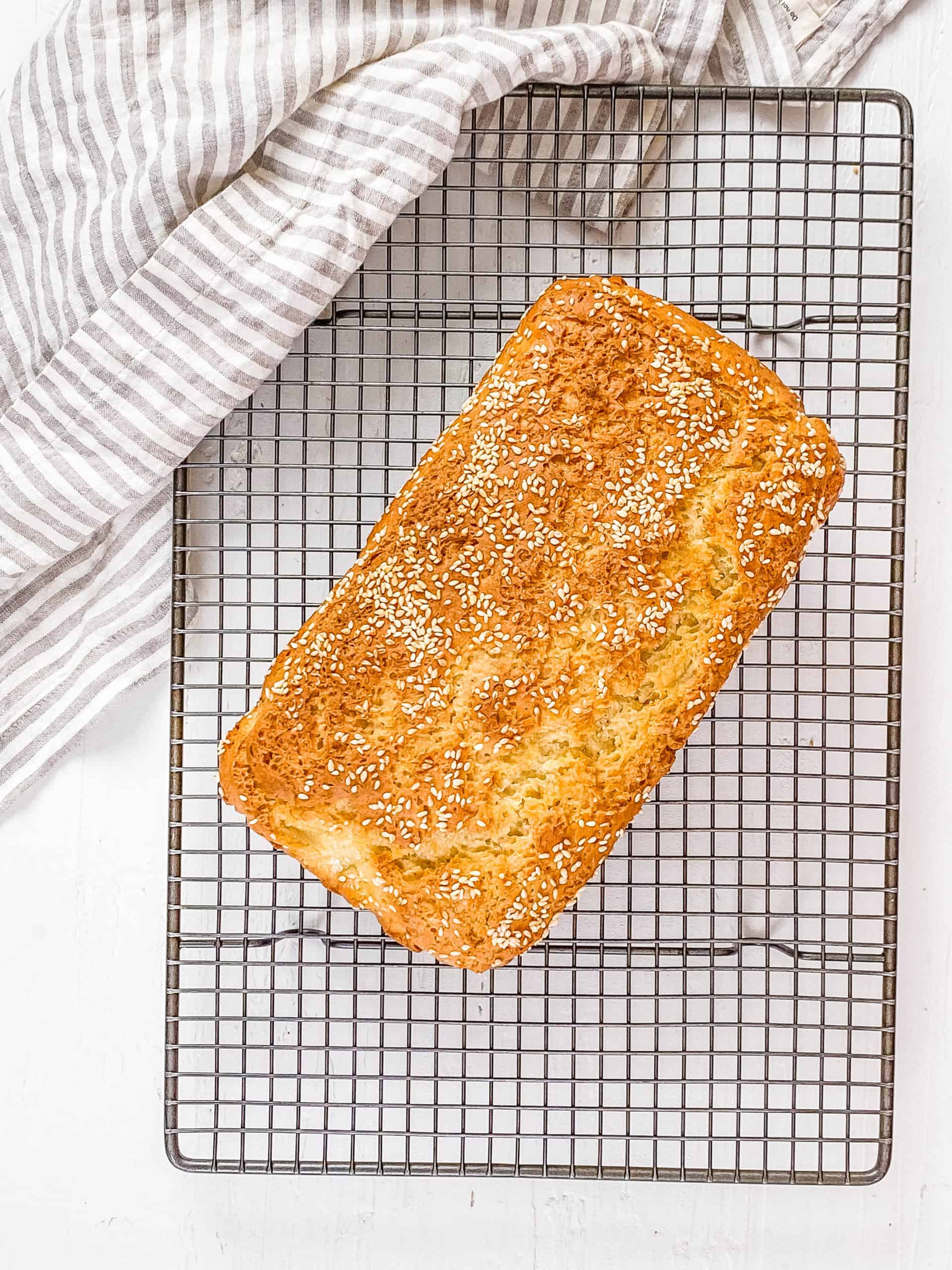
Slice And Serve: Once this low calorie gf bread has cooled completely, slice with a bread knife or any serrated knife, and serve at room temperature.
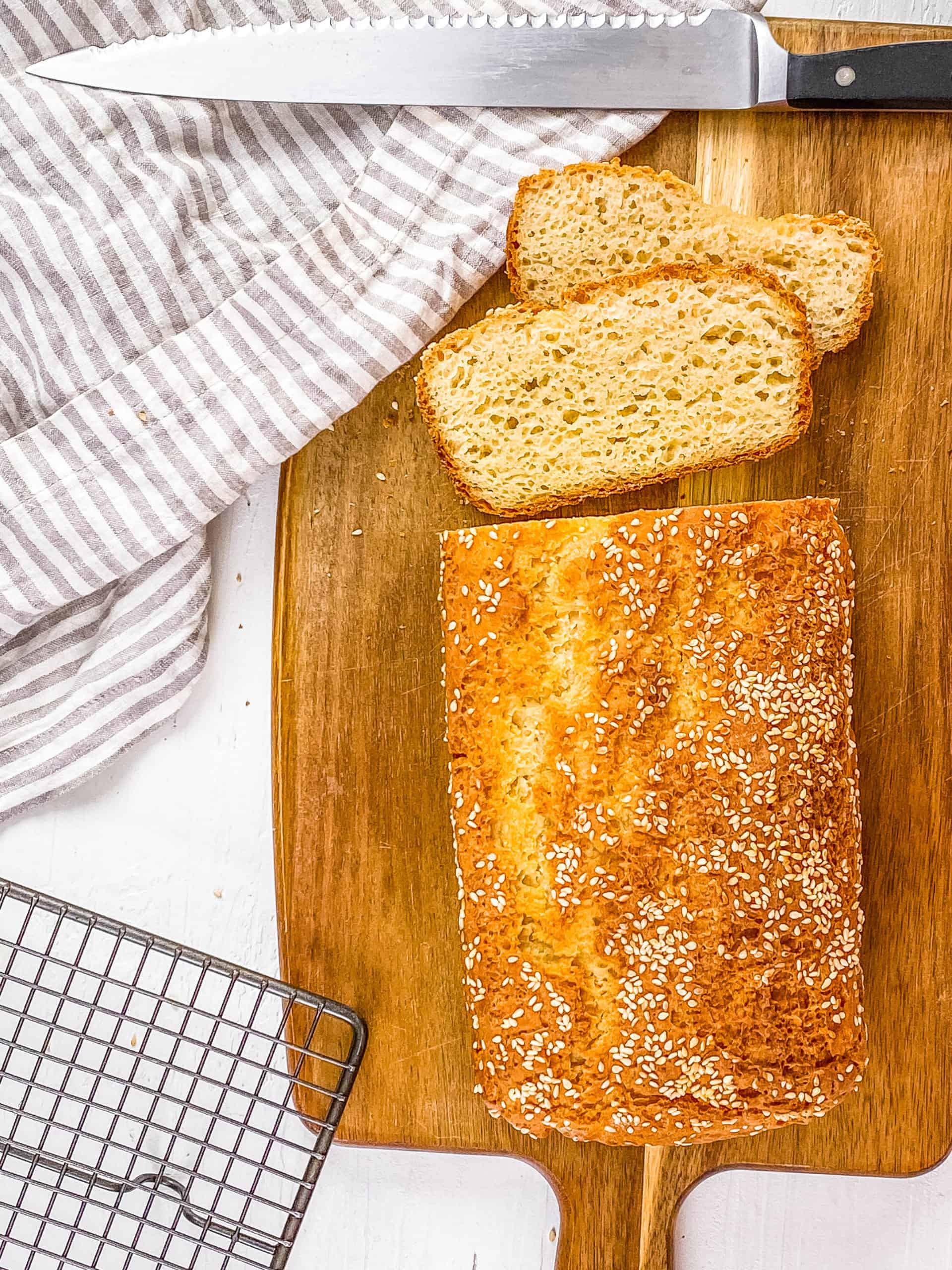
How To Make Gluten Free Bread In A Bread Machine
It’s actually really straight forward to make this gluten free sandwich bread in a bread machine! You’ll just have to use instant yeast instead of regular active dry yeast. Here’s how you do it:
- Add your wet ingredients into the bread pan: that would be the almond milk, olive oil, sugar, egg whites, and apple cider vinegar, in that order.
- Add your dry ingredients into the bread pan: the flour, baking powder, and salt.
- Make a hole in the center of the bread pan, and pour your instant yeast into the hole.
- Select the “gluten free bread” setting and start your bread machine.
Alternatively, you could add all the ingredients at once, and if you did that, the order of the ingredients would be: almond milk, egg whites, oil, apple cider vinegar, flour, salt, sugar, instant yeast. Then you’d select “gluten free bread” for the setting and hit start. Let the bread cool completely before slicing.
Note: If your bread machine does not have a gluten-free setting, choose the setting that has only one mixing cycle (typically it’ll be the “quick” or “basic” or “rapid” cycle). Select light or medium for the crust.
💭 Expert Tips
- There’s no need to knead this bread mixture, it’s as simple as mixing until a smooth batter is formed, allowing it to rise and then baking it.
- If your yeast is a little old and you’re not sure if it’s still active, you can test-proof the yeast before adding it to your bread flour mixture. To proof yeast, dissolve the yeast in warm water (between 95-100 degrees F) with a little honey or sugar and see if it forms small bubbles and becomes creamy (that means your yeast is still active). (Note – you can also proof yeast in milk or plant-based milk like in this recipe).
- Don’t warm your milk too much: The ideal temperature for instant yeast is 95°F–110°F. If the almond milk is any hotter than that, it could kill the yeast and your bread will not rise.
- Make sure you let your bread rise in a warm dry place. Room temperature is fine, but don’t let it rise in the oven or the fridge! The oven is too hot and will kill the yeast, the fridge is too cold and it will take forever to rise.
- Using a stand mixer is best for making your bread batter – it’s much harder to mix it by hand!
- Make sure to line your pan with parchment paper: If you are using a bread tin / loaf pan, line it with parchment paper and bake bread as described above to give your loaf of bread a more traditional shape, and for easy removal. The narrower your bread pan, the taller your bread will be. I used a 13×5 inch pan for this recipe. A Pullman loaf pan is meant to make a softer bread, so if you want your bread to be super soft, I’d say the Pullman loaf pan is the best bread pan for bread making!
- Ingredients at room temperature work best in this recipe. It’s important not to substitute any ingredients in this recipe as I can’t guarantee it will turn out as well (bread recipes can be finicky!)
- The gluten free flour you use will affect the texture of your bread! All gluten free flours are slightly different, so you might need to try one or two in order to get the right texture. Remember to add xanthan gum to the mix if the gf flour that you’re using doesn’t have it already added.
- Spoon and level dry ingredients! When you’re measuring out your dry ingredients, spoon both into your measuring cup and then level. That will ensure you don’t end up with too much flour and your bread won’t be overly dense.
- Don’t let your bread cool completely in the bread pan. The moisture from the bread will get trapped by the pan and the bottom of your bread will get soggy. Instead, let it cool for 5 minutes in a pan, then transfer to a wire rack to finish cooling.
- Toast the bread lightly before serving – it tastes best warm, but not so toasted that it becomes crunchy!
📖 Variations
- Easy Vegan Gluten Free Bread Recipe: This gluten free dairy free bread recipe can easily be made vegan by substituting aquafaba for the egg whites! Use 6 tablespoons of aquafaba as a replacement for the 3 egg whites to make a gluten free egg free bread recipe.
- Different Flour Options: The best flour to use for gluten free bread is a gluten free flour blend meant for yeast baking, with xanthan gum added. I like Bob’s Red Mill Gluten Free All Purpose Baking Flour, which is made specifically for baking yeast breads. While I also like Bob’s Red Mill Gluten Free 1:1 Flour, it’s not supposed to work as well for gluten free bread with yeast. I’ve heard that Better Batter and Pillsbury gluten free flour also works well. Keep in mind that if you use the Bob’s Red Mill, you will have to add 3.5 teaspoons of xanthan gum to this yeast bread recipe or your bread won’t rise properly.
- Gluten Free Nut Free Bread: Just use a different plant milk (like unsweetened oat milk or soy milk) instead of the almond milk to make this bread nut free!
- Different Toppings: I used sesame seeds, but you can use any mixture of nuts or seeds to top this bread! I like the texture and flavor the seeds provide. You can also just omit them altogether.
✔️ Troubleshooting Gluten-Free Bread Making
Baking is hard to master because it’s both an art and a science at the same time. You need to be very precise, but learning how to adapt your recipes to environmental conditions on the fly can be just as important.
Gluten-free baking is no exception, and can sometimes be even more challenging than regular baking!
Don’t give up if your first attempts at gluten-free sandwich bread don’t yield a perfect loaf. For best results, see the expert tips, and try these additional solutions to the most common gluten-free baking problems you’re likely to encounter when making bread!
How To Fix Gluten-Free Bread That’s Too Crumbly
With normal bread, chains of gluten proteins help hold the bread together. That’s why so many bread recipes don’t call for many binders, like eggs.
When it comes to gluten-free bread though you need something else to help the bread hold together and prevent too much crumbliness.
There are typically 3 reasons why your bread might be too crumbly: 1) You didn’t have enough liquid in the batter, 2) The batter needs more fat 3) You need more of a binder for the bread. The easiest way to add a little more binding power is to add an egg (or flax-eggs) to your bread to help keep everything together. Chia seeds or even plain flax seeds can also be good options.
Some gluten-free bakers also use binders like xanthan gum or guar gum to help hold their bread together. Usually, both of these ingredients are mixed in with the flour ahead of time to help it stick together.
How To Fix A Loaf That Is Too Dense
Typically a dense loaf of bread can be caused by two things: 1) Your leavening agent (baking powder, yeast) has expired or is stale, or you need more of it! 2) You didn’t measure the ingredients accurately. If your loaves are too dense (but still taste and look great) then you might want to add a little more leavening to the mix.
Baking soda, baking powder, and gluten-free yeast are all good options to achieve an airy loose texture. Yeast especially can add a little more flavor to this gf bread recipe, too. Make sure they are fresh for best results.
In terms of measuring ingredients, use the spoon and level method (spoon your ingredients into your measuring cup, level with the back of a knife), and weigh your ingredients for even more precision.
How To Fix A Gritty Bread Texture
Gritty bread is one of the most common struggles with homemade gluten-free bread. The issue can be either with the flour, or your baking time. All gluten free flour blends are slightly different, so the texture of the bread will vary depending on which flour you use. You might have to test a few to find the right one for your preferences!
You can also check your baking time, and make sure you’re not trying to bake your bread too quickly which doesn’t give the dough any time to rise and settle.
If you’re struggling with gritty texture you can try giving your bread batter a little longer to rise before you put it in the oven. The extra time should give the dough a chance to soften and will help bread batters even out.
What To Do If Your Gluten-Free Sandwich Bread Is Too Dry
Moisture is another struggle with gluten-free bread, but simply adding more water or milk to your dough usually isn’t the option. Instead, try to add moisture by adding a more substantial ingredient that’s less likely to evaporate in the oven.
Apple sauce is a great way to add a little more moisture. For savory breads, sour cream or yogurt can also add some moisture and protein to your finished bread. Just remember that sour cream and yogurt also add to the fat content and increase the calories in your bread significantly.
What To Do If Your Bread Has A Mushy Center Or A Dense Bottom
This problem is common in almost all bread baking. Mushy centers and dense bottoms are a sign that your bread is underbaked. It can also sometimes mean that you don’t have enough leavener, especially if baking longer leads to an overly dense texture or a hard bread.
Start by lowering your oven temperature and extending the cooking time slightly. Try reducing the temperature by 50 degrees (F) and baking for another 20-30 minutes. Make sure to check the bread a couple of times to make sure it isn’t finished baking early.
❓Recipe FAQs
If you’re making a yeast bread, you will want to use a gluten free flour blend meant for yeast bread recipes, that has xanthan gum added (or where you can add xanthan gum to the blend).
These five flours seem to work really well for yeast breads:
1) Arrowhead Mills Organic Gluten Free All Purpose Flour
2) Better Batter Blend
3) Judee’s All Purpose Gluten Free Bread Flour
4) Bob’s Red Mill Gluten Free All Purpose Baking Flour (need to add xanthan gum)
5) Pillsbury Gluten Free Flour Blend
You can also experiment with mixing your own gluten-free flour blend! That can be a great option to control what kinds of grain you’re using if you have other grain allergies. You can also use custom flour blends to improve the texture of your bread and other baked goods. If you want to switch up the flours in this recipe here are some other gluten-free flours that work well for baking bread:
– Buckwheat Flour
– Sorghum Flour
– Cassava Flour
– Millet Flour
– Oat Flour
– Brown Rice Flour
It may also be helpful to make your own gluten-free bread flour if you live at high elevations or in places where baking is a little different because of environmental factors. Feel free to experiment with different combinations of flours until you have the perfect combination for gluten-free bread and other gluten-free baked goods.
In traditional bread making, gluten is what causes bread to rise. Without gluten, you need a rising agent to help your bread rise! We make our gluten free bread recipe with yeast and baking powder, and choose a flour that has xanthan gum added to help this bread become nice and fluffy. Yeast, baking powder (or baking soda), and xanthan gum are the three ingredients that help gluten-free bread to rise.
Most yeast is gluten-free, but a couple of types of yeast are not. The two types of yeast that likely contain gluten are brewer’s yeast and yeast extract.
But these two types of yeast aren’t usually used for baking. The most common types of yeast used for baking (baker’s yeast, dry yeast, instant yeast) should all be gluten-free. Make sure to choose a gluten free certified yeast brand before baking!
Eggs are one of the most commonly used ingredients in gluten free sandwich bread and gluten free baking overall. This is because eggs act similarly to gluten in baked goods. Eggs provide functions like acting as a binder, giving you that soft fluffy texture of gluten-full recipes, and creating the right structure and crumb for the bread.
It depends! If you are buying an organic, gluten free sandwich bread that has no added sugar or processed ingredients, then yes, it is healthy. But a lot of gluten free bread brands are highly processed and have very little nutritional value, making them not great for you!
This recipe is super healthy because it is:
High in Fiber: One serving of this high fiber gluten free bread recipe has almost 6g of fiber. That’s more than double the amount in typical gluten-free breads!
High in Protein: Each serving of bread has 8g of protein.
Low in Sugar: Only about 2 grams of sugar in each slice of bread means it’s totally guilt-free!
There are some great store-bought options for gluten free bread! I have a few favorite brands – some of the best gluten-free sandwich breads I’ve found at the grocery store are:
** Happy Campers Organic Gluten Free Bread
** Canyon Bakehouse
** Franz Gluten Free Bread
** Udi’s Gluten Free
** Little Northern Bakehouse Bread Seeds & Grains Gluten Free
I do recommend storing this gluten free yeast bread recipe in the fridge because it doesn’t have any preservatives added, so storing it in the fridge (or the freezer) will lengthen it’s shelf life. You absolutely can store and freeze this bread if you want to make it in bulk in advance and use it for months!
To store in the fridge: Once the bread has cooled, slice it and wrap it tightly in plastic wrap, then wrap it in foil and place it in an airtight container. You can store it in the fridge for up to 2 weeks.
To freeze: Put the wrapped loaf in an airtight freezer bag or container. The bread will last in the freezer for up to 3 months. Defrost the bread in the fridge before use, and then heat it in a toaster oven or regular oven.
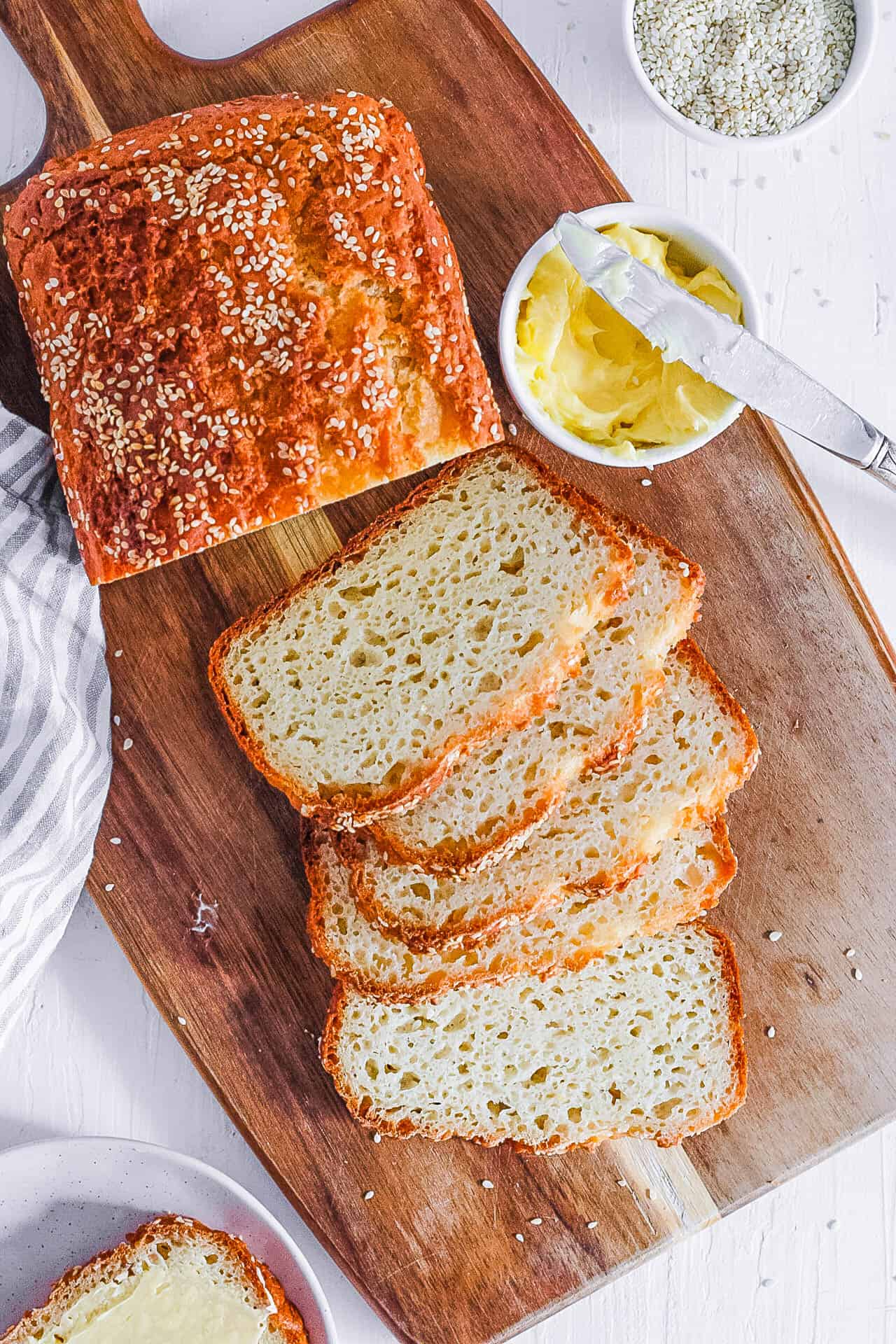
🍲 More Healthy Bread & Gluten Free Recipes!
- Gluten Free Lasagna
- Gluten Free Pasta Salad
- Buckwheat Bread
- Vegan Apple Crisp
- Gluten Free Brownies
- Gluten Free Focaccia
- Gluten Free Breakfast Cookies
- Vegetarian Gluten Free Recipes
Want to Save This Recipe?
Enter your email & I’ll send it to your inbox. Plus, get great new recipes from me every week!
By submitting this form, you consent to receive emails from The Picky Eater.
Love this plant based gluten free recipe? Please leave a 5-star rating 🌟 in the recipe below and/or a review in the comments section further down the page!
You can also FOLLOW ME on FACEBOOK, TWITTER, INSTAGRAM, and PINTEREST to see more delicious, healthy, family-friendly food, and if you have any questions, I’m here to help!
📋 Recipe Card
🎥 Watch How to Make It
Easy Homemade Gluten Free Bread Recipe
Ingredients
- 2¼ tsp Dried yeast
- 2 tbsp Sugar
- 1¼ cup Unsweetened almond milk warmed
- 3¼ cup Gluten-free flour
- 1 tsp Baking powder
- 1 tsp Salt
- 2 tsp Apple cider vinegar
- ¼ cup Olive oil
- 3 Egg whites
- 2 tbsp Sesame seeds optional
Instructions
To Make In The Oven
- In a small bowl mix together the yeast, sugar and warm milk. Stir, cover and set aside to proof for approx 10 minutes.
- Whisk together the flour, baking powder and salt in the bowl of a stand mixer.
- When the yeast starts to bubble add it, along with the apple cider vinegar, oil and egg whites to the flour mixture.
- Use the paddle attachment and beat the batter for 30 seconds until combined. Scrape down the edges and continue to beat for a further 3 minutes on a medium speed.
- Line a 13 x 5 inch bread tin with baking paper, lightly spray it with oil and fill the tin with batter. Smooth off the top with a spatula.
- Sprinkle with sesame seeds if using, loosely cover with plastic wrap and a tea towel and place in a warm spot to allow the dough to rise for 1 hour.
- When you have about 15 minutes left for your dough to finish rising, preheat the oven to 350 degrees F / 180 C.
- Remove the plastic wrap and place the bread tin in the oven. Cook for 60 – 65 minutes, cover with foil midway through to stop it from burning.
- When cooked through, remove from the oven, cool in the tin for 5 minutes then allow to cool completely on a cooling rack.
To Make In A Bread Machine
- Note: You will need instant yeast, not active dry yeast for this version. Add your wet ingredients into the bread pan: that would be the almond milk, olive oil, sugar, egg whites, and apple cider vinegar, in that order.
- Add your dry ingredients into the bread pan: the flour, baking powder, and salt.
- Make a hole in the center of the bread pan, and pour your yeast into the hole. Select the "gluten free bread" setting and start your bread machine.
- Alternatively, you could add all the ingredients at once, and if you did that, the order of the ingredients would be: almond milk, egg whites, oil, apple cider vinegar, flour, salt, sugar, yeast. Then you'd select "gluten free bread" for the setting and hit start. Let the bread cool completely before slicing.
- Note: If your bread machine does not have a gluten-free setting, choose the setting that has only one mixing cycle (typically it'll be the "quick" or "basic" or "rapid" cycle). Select light or medium for the crust.
Notes
- Add xanthan gum to the mix if the gluten free flour that you’re using doesn’t have it already added.
- There’s no need to knead this bread mixture, it’s as simple as mixing until a smooth batter is formed, allowing it to rise and baking. Super simple!
- Topping your bread with seeds is optional although they do add a delicious flavor.
- Store bread in an airtight container in a cool dry place.
- Allow bread to completely cool before slicing.
- Bread is best used within 24 hours of making.
- This bread toasts really well.
- Use a slightly wet spatula when smoothing off the top of the bread, this helps the batter to smooth evenly in the tin.
- For best results make sure to use baking powder and yeast that are not expired, and are fresh, and that all ingredients are at room temperature.
- Make sure your water is between 95-110 degrees before mixing it with the yeast and other ingredients.
- When you’re measuring out your dry ingredients, spoon both into your measuring cup and then level. That will ensure you don’t end up with too much flour and your bread won’t be overly dense.




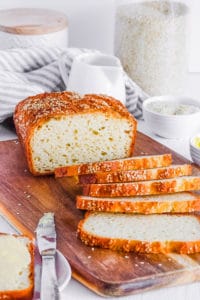

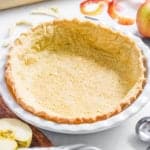

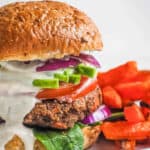



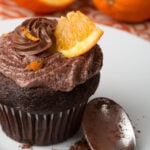
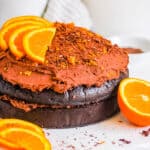
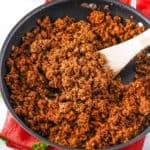
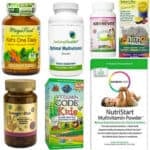
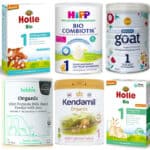

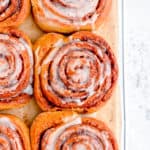
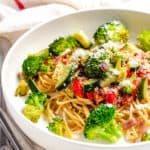
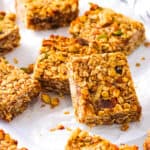
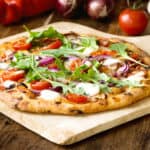


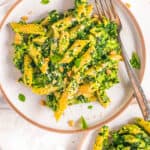
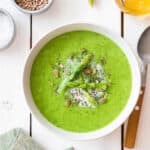
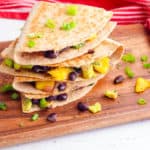
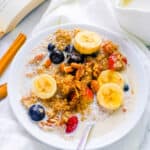

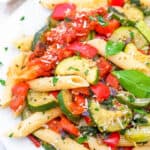


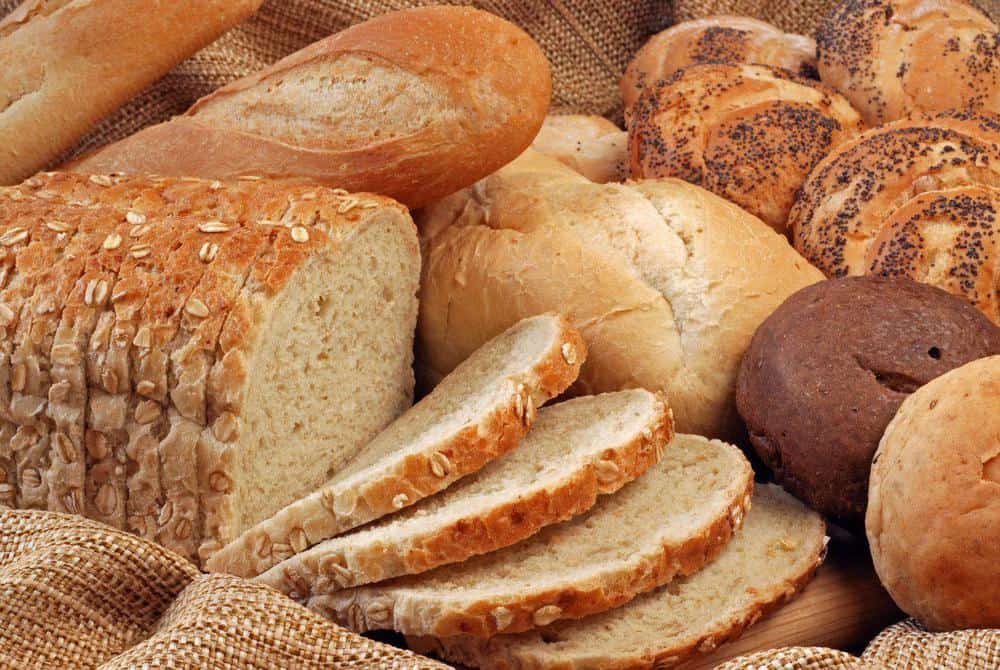
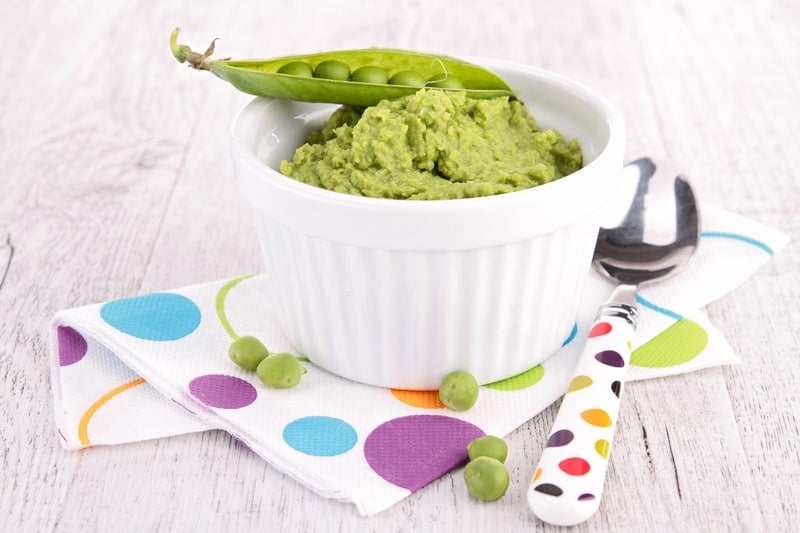
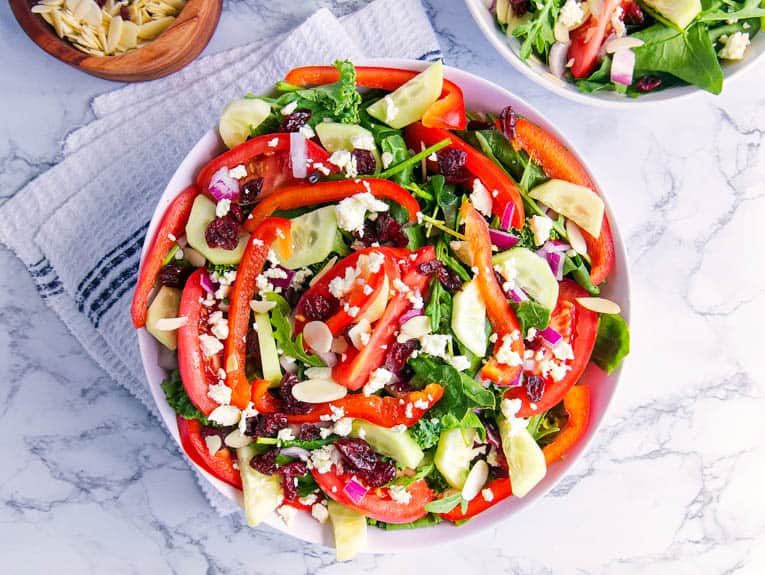


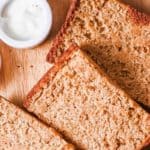
What are the calories per slice? I have looked and looked and may have missed it.
Hi Patricia! It’s 134 calories per slice 🙂 You can find all the nutritional information in the recipe card at the bottom of this post! Hope that helps!
Thank you for the very best gluten free bread my family and I have tasted so far! I make this in a bread machine. I’ve spent hundreds of dollars making GF bread at home , as well as buying bread in stores and online, often being disappointed. This recipe is simple and requires no special ingredients. Everything is probably already in your refrigerator and pantry. It’s perfect every time. One item to note, however, is that the batter looks runny while it’s mixing. I almost added more flour thinking I had made a mistake in the flour measurement. (This was the first time I looked in on the dough being mixed and was surprised) I refrained from adding more flour and it was PERFECT in the end. TO ME, THIS IS THE BEST GLUTEN FREE BREAD; soft, fluffy, and delicious. I hope anyone else trying this recipe has the same results.
Aww thank you so much Terry!! I’m so so happy to hear that – I love this recipe so much too, and I’m glad to hear you had a great experience with it. Thank you for letting me know!